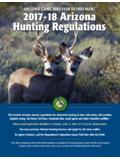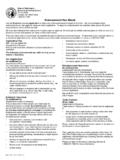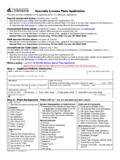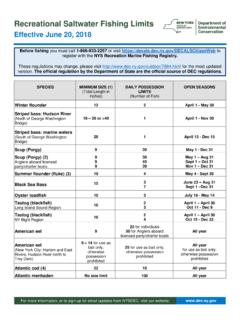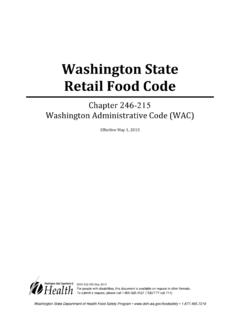Transcription of Fish Stocking Report 2017 - Connecticut
1 1 fish Stocking Report Connecticut department of Energy & Environmental Protection Bureau of Natural Resources Fisheries Division 79 Elm Street, Hartford, CT 06106 860-424- fish (3474) 2016 2 The fish Stocking Report is published annually by the department of Energy and Environmental Protection Robert Klee, Commissioner Susan Whalen, Deputy Commissioner Bureau of Natural Resources William A. Hyatt, Chief Fisheries Division Peter Aarrestad, Director 79 Elm Street Hartford, CT 06106-5127 860-424- fish (3474) ctfishandwildlife @ctfishinginfo Table of Contents Introduction 3 Connecticut s Stocked fish 3 DEEP State Hatcheries 6 Connecticut s Hatchery Raised Trout 9 Stocking Summary 2016 11 fish Distribution Numbers Catchable trout summary 12 Lakes and Ponds 13 River, Streams, and Brooks 17 Brown Trout fry 25 Broodstock Atlantic Salmon 26 Kokanee Salmon fry 26 Northern Pike 26 Walleye 26 Channel Catfish 27 Miscellaneous Inland Stocking 28 Migratory fish Species1 Stocking 29 Cover.
2 Nate Lewis of Norwalk holds a broodstock Atlantic salmon that he caught in the Naugatuck River, which is a very popular and unique fishery. 1 Atlantic Salmon, Sea-run Brown Trout, American Shad, Alewife, Sea Lamprey The Connecticut department of Energy and Environmental Protection is an Affirmative Action/Equal Opportunity Employer that is committed to complying with the requirements of the Americans with Disabilities Act. Please contact us at (860) 418-5910 or if you: have a disability and need a communication aid or service; have limited proficiency in English and may need information in another language; or if you wish to file an ADA or Title VI discrimination complaint.
3 3 INTRODUCTION Recreational fishing is a healthy outdoor experience that is important to the quality of life for many of Connecticut s residents and is beneficial to the state s economy. With over million fishing days enjoyed by adult anglers annually the benefits to Connecticut s economy are estimated to be approximately $436 million dollars per year2. A major objective of the Connecticut department of Energy and Environmental Protection s (DEEP) Fisheries Division (FD) is to enhance and diversify recreational fisheries. To support high-quality fishing experiences or to accelerate the pace of restoration, the State of Connecticut stocks fish that are reared at one of our three State fish hatcheries or in managed marshes, purchased with Federal Sportfish Restoration (SFR) funds, and that are captured during upstream migration.
4 Currently, Brown Trout, Brook Trout, Rainbow Trout, tiger trout (a Brown Trout/Brook Trout hybrid), Atlantic Salmon and Kokanee Salmon (a landlocked form of the anadromous Pacific Sockeye Salmon) are raised at one or more of the three State fish hatcheries. Other stocked species include Northern Pike (spawned in managed marshes and purchased from commercial vendors with SFR funds), Walleye and Channel Catfish (purchased from commercial vendors with SFR funds), and American Shad, Alewife, Sea Lamprey, and Blueback herring (captured as they migrate into freshwater to spawn). Connecticut s Stocked fish : TROUT: The FD stocks trout into waters that have suitable habitat and are open to public fishing. In general the FD stocks over 700,000 catchable sized trout each year into approximately 200 rivers/streams and 100 lakes/ponds.
5 Catchable sized trout can be adult (9-12 inches), specialty trout (12-14 inch range), or surplus broodstock (weighing 2-10 pounds or more). In addition, approximately 400,000 trout are stocked as yearlings (7-9 inches) or fry and fingerlings (1-6 inch trout). Springtime is the primary time for trout fishing in Connecticut . Trout distribution generally begins in late February and continues until mid-May. More than half the year s trout are stocked into their respective waters prior to Opening Day. A subset of waters (including a number of Trout Management Areas) are stocked in September and October to enhance fall and winter trout fishing. Innovative fish management tools such as minimum lengths, reduced creel limits, catch-and-release only areas and wild trout management areas are used to 2 department of the Interior, fish and Wildlife Service, and department of Commerce, Census Bureau.
6 2011 National Survey of Fishing, Hunting, and Wildlife-Associated Recreation ( Connecticut Summary). enhance angler opportunities in selected waters. Although these special management areas (Trout Parks, Trophy Trout Streams, Trout Management Areas, Trout Management Lakes and Wild Trout Management Areas) are perhaps the most noticeable and popular trout fishing areas, two-thirds of the catchable-sized trout stocked in Connecticut are released into open areas (where statewide regulations apply). Maps displaying Stocking points are available for over 200 locations on the DEEP web page at KOKANEE SALMON: Kokanee are a land-locked form of the Pacific Sockeye Salmon first introduced to Connecticut in the 1930 s. The DEEP currently maintains a Kokanee Salmon fishery in West Hill Pond (New Hartford/Barkhamsted) and East Twin Lake (Salisbury).
7 Each fall mature Kokanee are trap-netted and transported to the Burlington State fish Hatchery for spawning. The eggs are incubated and after they hatch are reared until the fry are stocked in the spring. Kokanee can be caught in West Hill Pond, East Twin Brown Trout 4 Lake, and occasionally Lake Wononskopomuc (Salisbury). Currently, DEEP stocks approximately 90,000 fry into East Twin Lake and 50,000 fry into both West Hill Pond and Lake Wononskopomuc. NORTHERN PIKE: Northern Pike fisheries are developed and maintained by Stocking fingerlings (3 - 8") that are raised in managed marshes located in Haddam, Kent, Litchfield and Mansfield. Adult pike are trapped from Bantam Lake and the Connecticut River and placed into the mashes where they spawn.
8 After spawning, the adult pike are returned to their respective waterbody. Pike fry growth and survival are maximized by managing the water level, vegetation type and by limiting predatory fish species. Within a few months pike fingerlings are captured by lowering the water level in each of the marshes. In addition to DEEP stockings, the Lake Lillinonah Authority purchases and stocks approximately 600 pike yearlings into Lake Lillinonah annually. WALLEYE: DEEP began to develop walleye fisheries in 1993, which are supported through annual stockings of 4 to 6 inch fingerlings purchased using Federal Sportfish Restoration Funds. Walleye are stocked at rates of 8-15 fish per acre in each lake. The developing fishery in each lake is evaluated by monitoring the growth and abundance of walleye and other fish species and by measuring angler effort and fishing success.
9 In addition to fish purchased and stocked by DEEP, the South Central CT Regional Water Authority, Aquarion Water Company, and Town of East Hampton also purchase Walleye (stocked into water company property waters and Lake Pocotopaug respectively). CHANNEL CATFISH: Expanding upon the popularity of the Channel Catfish fishery in the Connecticut River and privately owned waters stocked by individuals, the FD began Stocking Channel Catfish in 2007. The FD stocks Channel Catfish as either yearlings (ready for harvest in 2-3 years) or adult-sized fish (ready for immediate harvest). The objective of Stocking Channel Catfish is to provide a high quality year round fishery, especially in areas with high population density. ATLANTIC SALMON: From 1992 to 2013, the FD annually stocked over one million juvenile salmon (fry, parr, and smolts) as part of a multi-state and Federal effort to restore Atlantic salmon to the Connecticut River watershed.
10 The Federal effort concluded in in 2013, however, the FD still is planning to maintain enough salmon at the Kensington State fish Hatchery to preserve the genetic integrity of the Connecticut River strain. The FD plans on Stocking approximately one hundred thousand newly-hatched salmon fry into selected streams within the Farmington and Salmon River watersheds as part of a Legacy Program to insure the continued presence of Atlantic salmon in Connecticut . It is important to note that any juvenile or adult salmon captured within the Farmington River, Salmon River, or anywhere else in the Connecticut River watershed are a result of these stockings. All salmon accidently captured in these waters must be released immediately without avoidable injury.










